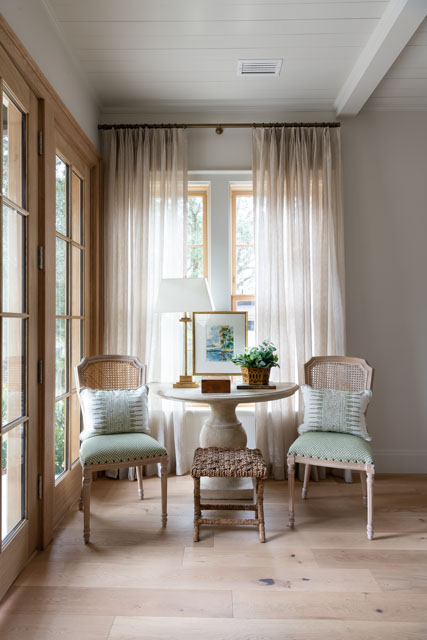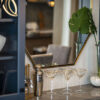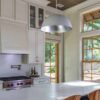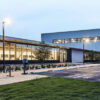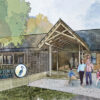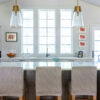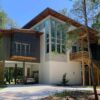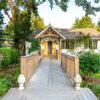Foyer and Dining Room
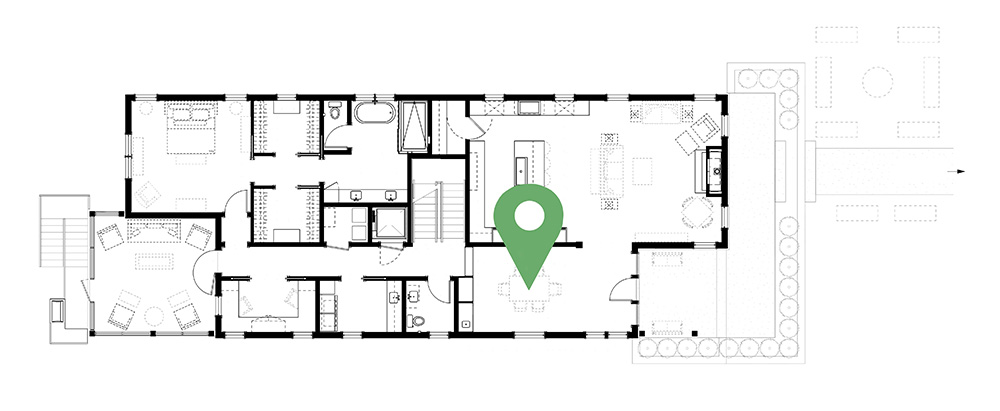
Sustainable Design Strategies
Planning and Design
![]()
One of the mantras of sustainable design is “long life, loose fit.” Highly specialized spaces for specific functions can become obsolete over time, making it more difficult and resource intensive for the building to be used for 50 or 100 years. The Foyer and Dining Room share the same space at the entry of the house. The layout offers flexibility for the dining room table to be extended to seat 10 or 12 for a holiday feast, but remain cozy enough for an intimate family dinner in normal use. White oak shelves anchor the room, giving it the character of a study or library, and inviting other uses for the space between meal times.
The shelves frame a view through the house to the back porch. While the room has a strong sense of enclosure, there are views to the outside from every angle so that the quality of light changes with the time of day and season. There is some separation from Living and Kitchen areas, but an easy flow between the spaces. This was intended to provide a relaxing setting for meals apart from the mess of food preparation, but close enough that it’s clearly intended for everyday use.
“Color Tunable” Lighting
 Our bodies evolved in sunlight. Daylight changes in color throughout the day, from warm morning light, to cooler and brighter mid day light, back to warm evening light. Exposure to those shifting color temperatures defines our circadian rhythms, which in turn regulate our sleep cycles, our weight, and our health. We see technology adapting to recognize this, with phones that change to a warmer screen color in the evening to help prepare people for sleep.
Our bodies evolved in sunlight. Daylight changes in color throughout the day, from warm morning light, to cooler and brighter mid day light, back to warm evening light. Exposure to those shifting color temperatures defines our circadian rhythms, which in turn regulate our sleep cycles, our weight, and our health. We see technology adapting to recognize this, with phones that change to a warmer screen color in the evening to help prepare people for sleep.
Nora Lighting’s 2” Iolite recessed LED luminaires are equipped with “comfort dim” technology, so that it is “color tunable” from a bright sunny 3100K, to a dimmed glow at 2,000K, which is more like candlelight. This allows the interior lighting to go through the same color shifts as the light outdoors, supporting healthy circadian function and healthy sleep.
The lights also have a color rendering index of 90+ which means they will not distort your perception of color. 90% of all lighting is required to be efficient for Zero Energy Ready Certification. 100% of the lighting in this home uses super efficient LED light sources. Efficient LED Lighting reduces energy use and heat generation associated with lighting. LED’s also have an extremely long life, approximately 50 times longer than a typical incandescent, 20-25 times longer than a typical halogen, and 8-10 times longer than a typical CFL. Depending on how many hours a day the lights are used, a homeowner may only have to change an LED every 11-18 years.
Decorative Lighting
![]() Decorative lighting fixtures were chosen for both their form, and their ability to add a layer of dynamic light and shadow to the ambient lighting of the room. The botanical form of the fixtures references leaves or feathers, and flowers reinforcing a biophilic interior environment. The foyer fixtures creates interesting patterns of light and shadow on the ceiling, and the wall sconces act like a pair of candles, framing the circular window with a warm pool of light. The chandelier creates a focal point around the dining room table. All the fixtures are energy efficient LED fixtures, but the layering of light levels, light quality and color temperature gives the room a huge amount of flexibility, so that it can set the stage for an impromptu meeting or candlelit dinner equally well.
Decorative lighting fixtures were chosen for both their form, and their ability to add a layer of dynamic light and shadow to the ambient lighting of the room. The botanical form of the fixtures references leaves or feathers, and flowers reinforcing a biophilic interior environment. The foyer fixtures creates interesting patterns of light and shadow on the ceiling, and the wall sconces act like a pair of candles, framing the circular window with a warm pool of light. The chandelier creates a focal point around the dining room table. All the fixtures are energy efficient LED fixtures, but the layering of light levels, light quality and color temperature gives the room a huge amount of flexibility, so that it can set the stage for an impromptu meeting or candlelit dinner equally well.
Bookshelves and Bar Cabinets
![]()
The plywood and composite wood used in cabinets can contain formaldehyde, a toxic substance associated with certain cancers. Indoor air Plus Certification requires cabinets to meet strict requirements for formaldehyde and other toxic substances. The unpainted bookshelves and bar cabinets are made of white oak and award winning “purebond” plywood that replaces formaldehyde adhesives with soy based adhesives. They are finished with a low emitting wax that highlights the character of the natural wood. Local manufacture in Fairhope Alabama reduces the emissions and carbon impact related to transporting the cabinets to the job site.
Smart Beverage Faucet
![]() The WaterSense certified beverage faucet by Brizo pairs clean Scandinavian design with smart technology to prevent the spread of germs. Since this fixture is likely to be shared by multiple guests, it can be turned on by the tap of a water glass, with the need to touch the handle.
The WaterSense certified beverage faucet by Brizo pairs clean Scandinavian design with smart technology to prevent the spread of germs. Since this fixture is likely to be shared by multiple guests, it can be turned on by the tap of a water glass, with the need to touch the handle.
WaterSense certified faucets conserve both water and energy, by reducing hot water use, and increasing savings on utility bills. The average family could save 700 gallons of water a year by switching to WaterSense certified faucets.
Porcelain Countertops
![]() Porcelain countertops evoke natural textures and forms that reinforce the biophilic interior environment. Crossville porcelain slabs are made in Crossville TN, less than 500 miles from Fairhope, and between 95%-95% of the materials used in these products are sourced from within 500 miles of the factory. Using local and regional materials reduces the carbon impact and emissions associated with the transporting of raw and finished materials over long distances.
Porcelain countertops evoke natural textures and forms that reinforce the biophilic interior environment. Crossville porcelain slabs are made in Crossville TN, less than 500 miles from Fairhope, and between 95%-95% of the materials used in these products are sourced from within 500 miles of the factory. Using local and regional materials reduces the carbon impact and emissions associated with the transporting of raw and finished materials over long distances.
Crossville is a leader in sustainable manufacturing processes. They reuse more than 99.98 percent of water used in manufacturing. The small amount that is not reused is returned clean to the environment. Through a certified recycling process, they recycle approximately 12 million pounds of material that previously went to landfills. Crossville remains the only tile manufacturer with a Tile Take-BackTM Program, allowing previously installed tile from any manufacturer to be returned to Crossville for recycling. Crossville works with TOTO USA, the world’s largest plumbing products manufacturer, to recycle pre-consumer waste. Crossville has developed a proprietary system of processing TOTO’s sanitary ware waste back into powder used in manufacturing new tile. In March 2011, Crossville became a net consumer of waste, meaning they recycle more waste into new products. This recycling conserves resources; the volume of finished goods Crossville ships now exceeds the amount of raw materials it extracts from the earth for use in manufacturing.
Crossville tile and porcelain slabs are clean materials. The ingredients used in the porcelain slabs are fully disclosed down to one part per million, and are disclosed through the Declare (link) Health Product Declaration to contain no red list (link) ingredients. Crossville also provides an Environmental Product Declaration quantifying the life cycle impacts of its products.
Wood Flooring
![]() The wood flooring used throughout the Inspiration home is a pale white oak with distinctive graining and a matte finish that gives it the appearance of unfinished wood. Using visibly identifiable natural materials is a biophilic design strategy that has been proven to provide emotional and cognitive benefits, including decreased blood pressure, increased creativity, and increased comfort. Learn more by reading The 14 Patterns of Biophilic Design by Terrapin Bright Green.
The wood flooring used throughout the Inspiration home is a pale white oak with distinctive graining and a matte finish that gives it the appearance of unfinished wood. Using visibly identifiable natural materials is a biophilic design strategy that has been proven to provide emotional and cognitive benefits, including decreased blood pressure, increased creativity, and increased comfort. Learn more by reading The 14 Patterns of Biophilic Design by Terrapin Bright Green.
The adhesives and sealants used in its installation, are GreenGuard certified for low emissions. Products with GREENGUARD Certification are compliant with stringent emission levels for over 360 Volatile Organic Compounds (VOCs), plus a limit on the total of all chemical emissions combined (TVOC).
UltraLight Gypsum Drywall
![]() US Gypsum USG Sheetrock® Brand UltraLight Panels are Greenguard Gold certified, low emitting materials. Sheetrock is ubiquitous in construction, it is a heavy material used in large quantities. Using light weight drywall is a simple step that greatly reduces the pollution associated with transporting the materials from manufacture to the site.
US Gypsum USG Sheetrock® Brand UltraLight Panels are Greenguard Gold certified, low emitting materials. Sheetrock is ubiquitous in construction, it is a heavy material used in large quantities. Using light weight drywall is a simple step that greatly reduces the pollution associated with transporting the materials from manufacture to the site.
USG Sheetrock® Brand UltraLight Panels are 1/2 in. (12.7 mm) gypsum panels that feature proprietary core and paper technologies, resulting in a high strength-to-weight ratio composite design. These lightweight panels are also engineered to have superior sag resistance, eliminating the need for traditional 1/2 in. (12.7 mm) sag-resistant ceiling panels. The noncombustible gypsum core is encased in 100% recycled face and back papers, The light weight design is easier for installers to work with, and can improve construction speed and safety.
People tend to think of the environmental impact of a home or building in terms of energy use and utility bills. However, building materials also create significant environmental impacts, through the pollution associated with their extraction, manufacture, and transportation to the job site. This is called “embodied carbon,” with carbon being an indicator of all greenhouse gases, not just carbon dioxide. The environmental impacts of building materials are also front loaded in time, while a building’s energy use creates incremental impacts over a lifetime of use. Since the emissions that we produce between now and 2050 will determine whether or not we avoid the worst impacts of climate change, the embodied carbon of building materials matters a great deal.
For the greatest impact, prioritize the selection of locally produced and sustainably manufactured materials for heavy items that are needed in large quantities, like brick, concrete, framing, or drywall.

Wood Doors and Trim
![]() Solid wood doors and finger jointed molding use wood sourced from Koetter’s own managed forests that were planted from vacant land. Keotter has won multiple awards for forest management Including the “Good Steward” award from the Arbor Day foundation and the Forestry Award from the Indiana Wildlife Federation. Solid wood doors are naturally low emitting materials. Finger jointed molding conserves materials by utilizing smaller pieces of wood joined together.
Solid wood doors and finger jointed molding use wood sourced from Koetter’s own managed forests that were planted from vacant land. Keotter has won multiple awards for forest management Including the “Good Steward” award from the Arbor Day foundation and the Forestry Award from the Indiana Wildlife Federation. Solid wood doors are naturally low emitting materials. Finger jointed molding conserves materials by utilizing smaller pieces of wood joined together.
The curved shapes of moldings and door panels balance the strong lines of the cabinets and reinforce the biophilic interior design, by echoing organic forms, like the curve of a wave or a seashell.
Interior Paint
![]() The interior paint is Greenguard Gold certified as a low emitting material, or has an equivalent certification with small chamber testing. This means that the paint has been tested in a sealed chamber where any off gassing can be analyzed and measured for compliance with health standards. This is not the same as being labeled “low emitting”. Many products are labeled “low emitting” that simply meet legal requirements for the volatile organic compounds in their ingredients. They may only be “low” compared to materials that are no longer legal to use, hardly something to brag about.
The interior paint is Greenguard Gold certified as a low emitting material, or has an equivalent certification with small chamber testing. This means that the paint has been tested in a sealed chamber where any off gassing can be analyzed and measured for compliance with health standards. This is not the same as being labeled “low emitting”. Many products are labeled “low emitting” that simply meet legal requirements for the volatile organic compounds in their ingredients. They may only be “low” compared to materials that are no longer legal to use, hardly something to brag about.
Indoor Air Plus certification requires that 90% of all paints, stains, and coatings applied inside the home meet GreenGuard Gold or an equivalent certification. Not only the paint, but also all of the stains, coatings, adhesives, sealants, and caulks in this home were carefully screened to prevent emissions that could contaminate the interior of this home.
All of the paint colors used in the Inspiration Home contain no black or grey pigment, which make them extremely dynamic and responsive to differing conditions of daylight. This mimics the dynamic appearance of colors found in nature and is one of our biophilic design strategies.

